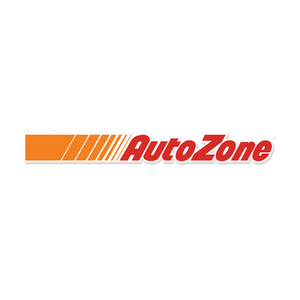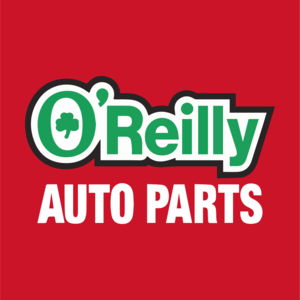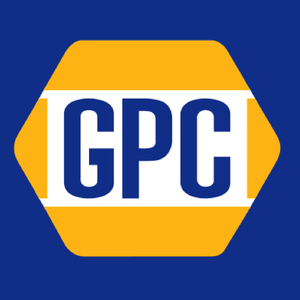
Monro (MNRO)
Monro is in for a bumpy ride. Not only are its sales cratering but also its low returns on capital suggest it struggles to generate profits.― StockStory Analyst Team
1. News
2. Summary
Why We Think Monro Will Underperform
Started as a single location in Rochester, New York, Monro (NASDAQ:MNRO) provides common auto services such as brake repairs, tire replacements, and oil changes.
- Ongoing store closures and lackluster same-store sales indicate sluggish demand and a focus on consolidation
- ROIC of 4.8% reflects management’s challenges in identifying attractive investment opportunities, and its shrinking returns suggest its past profit sources are losing steam
- Smaller revenue base of $1.19 billion means it hasn’t achieved the economies of scale that some industry juggernauts enjoy


Monro falls short of our quality standards. We believe there are better businesses elsewhere.
Why There Are Better Opportunities Than Monro
Why There Are Better Opportunities Than Monro
Monro is trading at $20.49 per share, or 37.8x forward P/E. This multiple expensive for its subpar fundamentals.
Paying a premium for high-quality companies with strong long-term earnings potential is preferable to owning challenged businesses with questionable prospects. That helps the prudent investor sleep well at night.
3. Monro (MNRO) Research Report: Q3 CY2025 Update
Auto services provider Monro (NASDAQ:MNRO) missed Wall Street’s revenue expectations in Q3 CY2025, with sales falling 4.1% year on year to $288.9 million. Its non-GAAP profit of $0.21 per share was 16.7% above analysts’ consensus estimates.
Monro (MNRO) Q3 CY2025 Highlights:
- Revenue: $288.9 million vs analyst estimates of $297.4 million (4.1% year-on-year decline, 2.8% miss)
- Adjusted EPS: $0.21 vs analyst estimates of $0.18 (16.7% beat)
- Operating Margin: 4.4%, in line with the same quarter last year
- Locations: 1,116 at quarter end, down from 1,272 in the same quarter last year
- Same-Store Sales rose 1.1% year on year (-5.8% in the same quarter last year)
- Market Capitalization: $542 million
Company Overview
Started as a single location in Rochester, New York, Monro (NASDAQ:MNRO) provides common auto services such as brake repairs, tire replacements, and oil changes.
The core customer is someone who relies on their cars for daily needs, which is most of suburban and rural America. Monro understands that these car owners have busy lives and may lack the expertise to diagnose and address issues with their automobiles. The company therefore aims to be a one-stop-shop for everything from periodic maintenance to more involved repairs.
Monro locations are moderate in size, typically 5,000 square feet and equipped with specialty tools and technology for auto repairs. These locations are strategically located in suburban areas, close to residential neighborhoods and major roadways. Even though you can’t have your car fixed online, Monro does have an e-commerce presence where customers can schedule appointments, access information Monro’s services, and even purchase products like tires and motor oil.
4. Auto Parts Retailer
Cars are complex machines that need maintenance and occasional repairs, and auto parts retailers cater to the professional mechanic as well as the do-it-yourself (DIY) fixer. Work on cars may entail replacing fluids, parts, or accessories, and these stores have the parts and accessories or these jobs. While e-commerce competition presents a risk, these stores have a leg up due to the combination of broad and deep selection as well as expertise provided by sales associates. Another change on the horizon could be the increasing penetration of electric vehicles.
Auto parts and services providers include Advance Auto Parts (NYSE:AAP), AutoZone (NYSE:AZO), O’Reilly Automotive (NASDAQ:ORLY), and private company Pep Boys.
5. Revenue Growth
A company’s long-term sales performance is one signal of its overall quality. Even a bad business can shine for one or two quarters, but a top-tier one grows for years.
With $1.19 billion in revenue over the past 12 months, Monro is a small retailer, which sometimes brings disadvantages compared to larger competitors benefiting from economies of scale and negotiating leverage with suppliers.
As you can see below, Monro struggled to increase demand as its $1.19 billion of sales for the trailing 12 months was close to its revenue six years ago (we compare to 2019 to normalize for COVID-19 impacts). This was mainly because it closed stores and observed lower sales at existing, established locations.
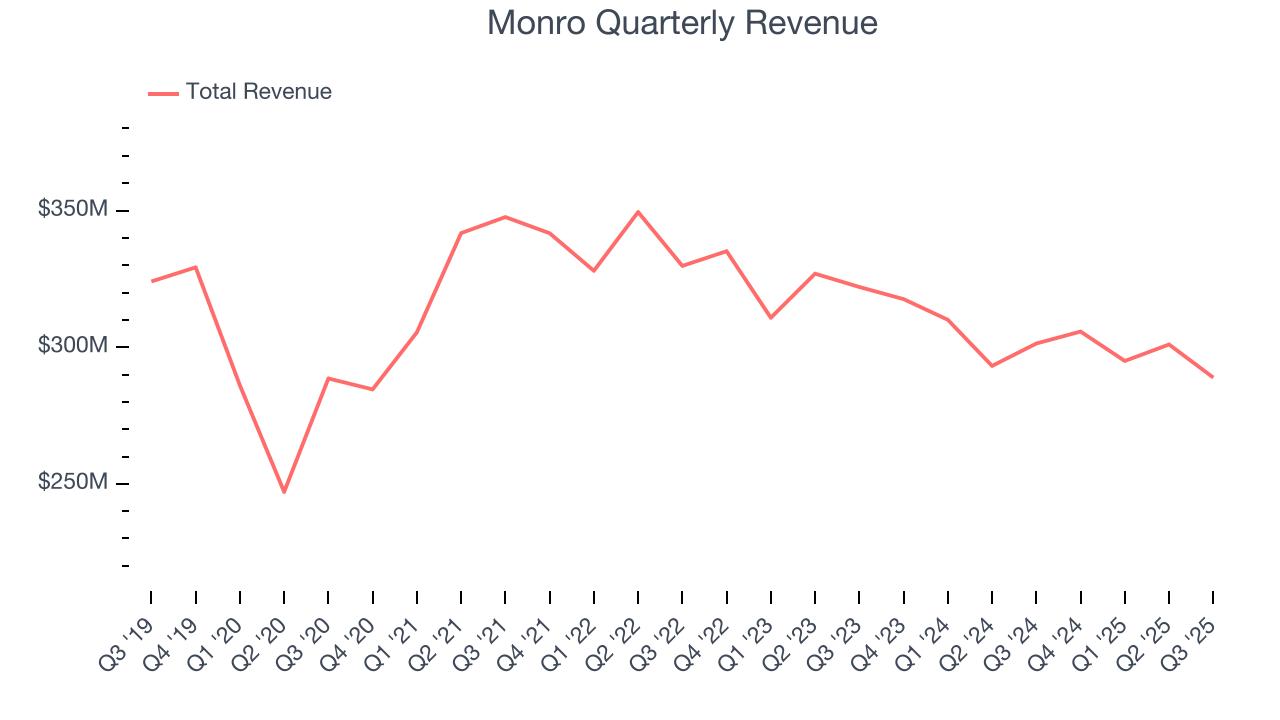
This quarter, Monro missed Wall Street’s estimates and reported a rather uninspiring 4.1% year-on-year revenue decline, generating $288.9 million of revenue.
Looking ahead, sell-side analysts expect revenue to grow 1.3% over the next 12 months. Although this projection suggests its newer products will spur better top-line performance, it is still below the sector average.
6. Store Performance
Number of Stores
Monro operated 1,116 locations in the latest quarter. Over the last two years, the company has generally closed its stores, averaging 4.3% annual declines.
When a retailer shutters stores, it usually means that brick-and-mortar demand is less than supply, and it is responding by closing underperforming locations to improve profitability.
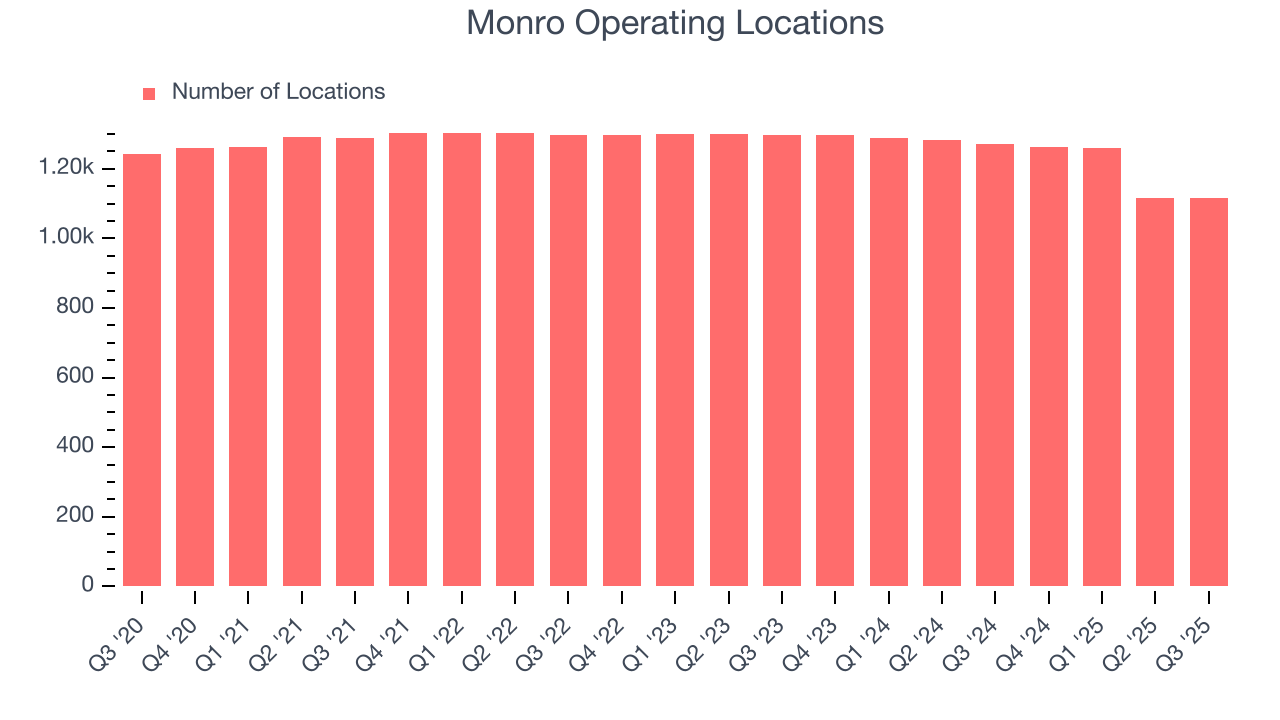
Same-Store Sales
A company's store base only paints one part of the picture. When demand is high, it makes sense to open more. But when demand is low, it’s prudent to close some locations and use the money in other ways. Same-store sales is an industry measure of whether revenue is growing at those existing stores and is driven by customer visits (often called traffic) and the average spending per customer (ticket).
Monro’s demand has been shrinking over the last two years as its same-store sales have averaged 2.2% annual declines. This performance isn’t ideal, and Monro is attempting to boost same-store sales by closing stores (fewer locations sometimes lead to higher same-store sales).
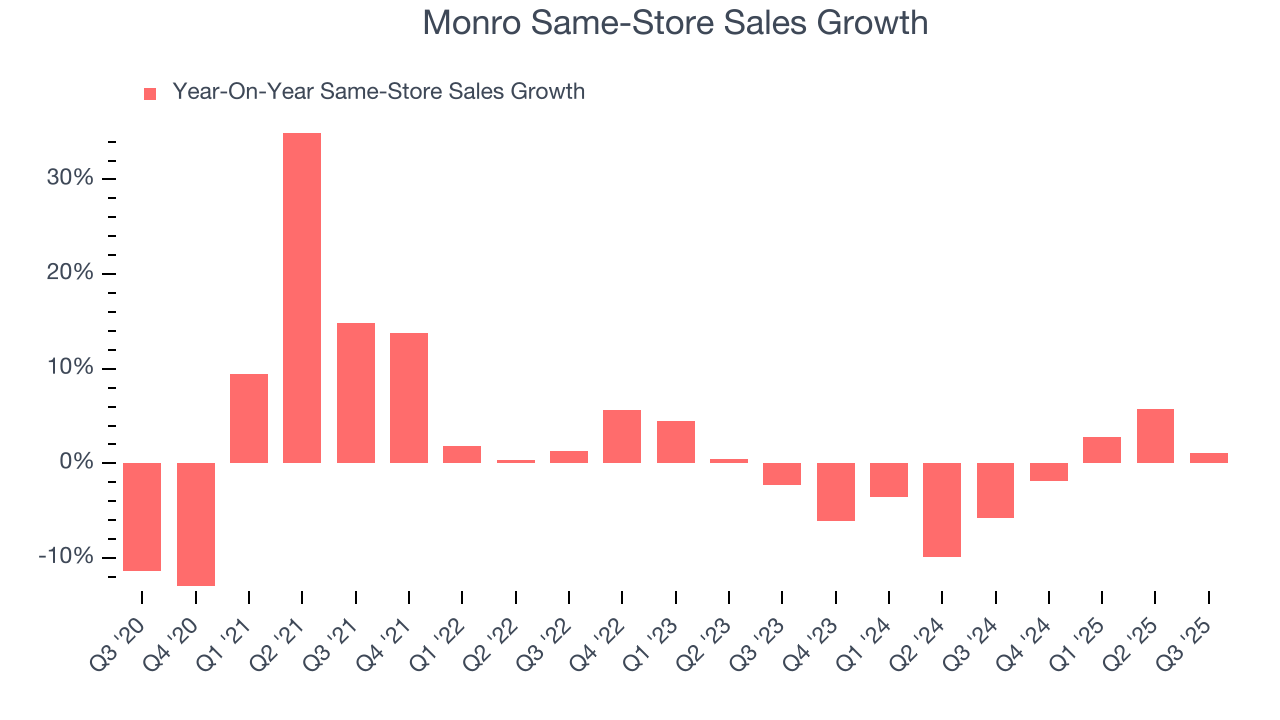
In the latest quarter, Monro’s same-store sales rose 1.1% year on year. This growth was a well-appreciated turnaround from its historical levels, showing the business is regaining momentum.
7. Gross Margin & Pricing Power
We prefer higher gross margins because they not only make it easier to generate more operating profits but also indicate product differentiation, negotiating leverage, and pricing power.
Monro’s unit economics are higher than the typical retailer, giving it the flexibility to invest in areas such as marketing and talent to reach more consumers. As you can see below, it averaged a decent 35.2% gross margin over the last two years. Said differently, Monro paid its suppliers $64.76 for every $100 in revenue. 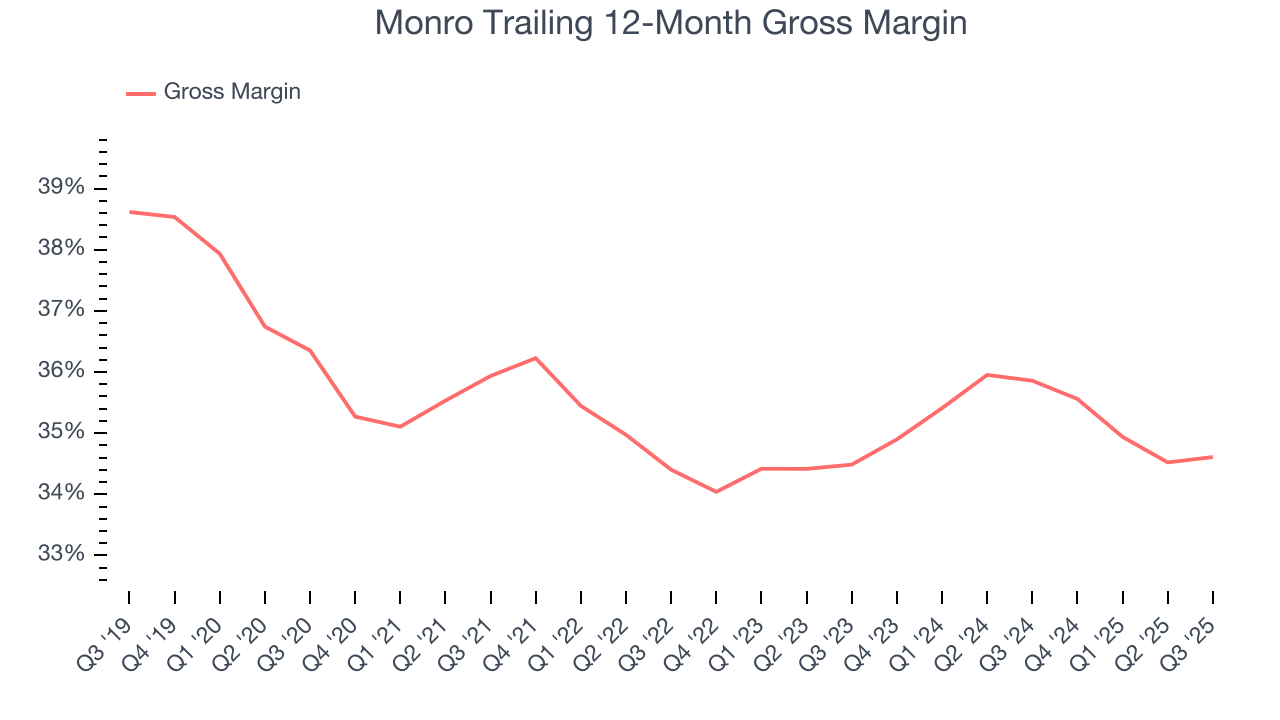
In Q3, Monro produced a 35.7% gross profit margin, in line with the same quarter last year. Zooming out, Monro’s full-year margin has been trending down over the past 12 months, decreasing by 1.2 percentage points. If this move continues, it could suggest a more competitive environment with some pressure to discount products and higher input costs (such as labor and freight expenses to transport goods).
8. Operating Margin
Operating margin is an important measure of profitability for retailers as it accounts for all expenses necessary to run a store, including wages, inventory, rent, advertising, and other administrative costs.
Monro was profitable over the last two years but held back by its large cost base. Its average operating margin of 2.1% was weak for a consumer retail business.
Analyzing the trend in its profitability, Monro’s operating margin decreased by 5.4 percentage points over the last year. Monro’s performance was poor no matter how you look at it - it shows that costs were rising and it couldn’t pass them onto its customers.
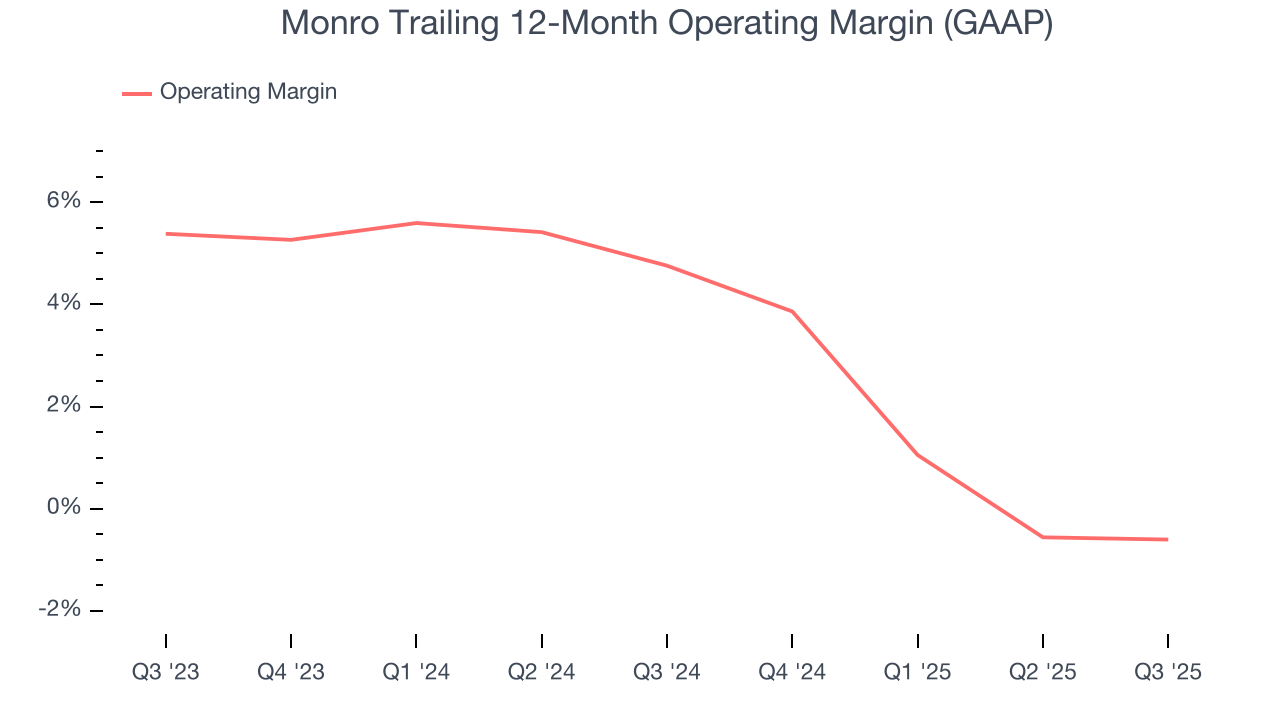
This quarter, Monro generated an operating margin profit margin of 4.4%, in line with the same quarter last year. This indicates the company’s cost structure has recently been stable.
9. Cash Is King
Free cash flow isn't a prominently featured metric in company financials and earnings releases, but we think it's telling because it accounts for all operating and capital expenses, making it tough to manipulate. Cash is king.
Monro has shown robust cash profitability, giving it an edge over its competitors and the ability to reinvest or return capital to investors. The company’s free cash flow margin averaged 5.3% over the last two years, quite impressive for a consumer retail business. The divergence from its underwhelming operating margin stems from the add-back of non-cash charges like depreciation and stock-based compensation. GAAP operating profit expenses these line items, but free cash flow does not.
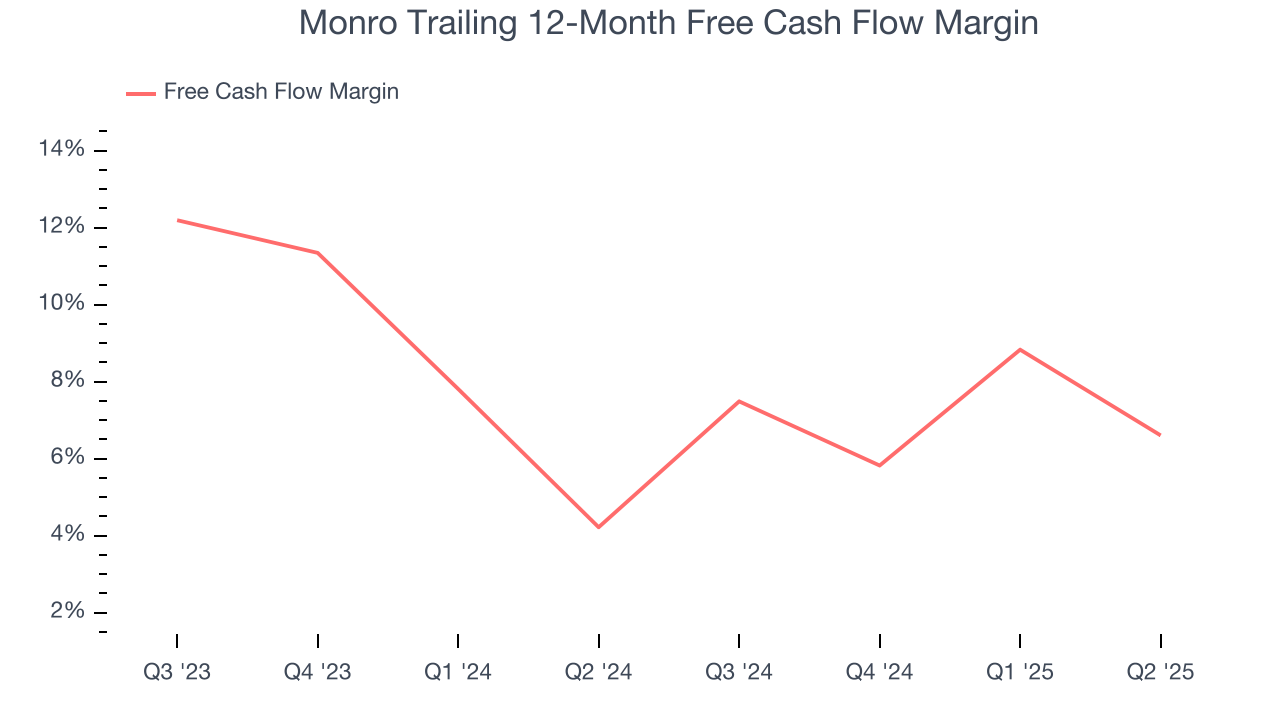
10. Return on Invested Capital (ROIC)
EPS and free cash flow tell us whether a company was profitable while growing its revenue. But was it capital-efficient? Enter ROIC, a metric showing how much operating profit a company generates relative to the money it has raised (debt and equity).
Monro historically did a mediocre job investing in profitable growth initiatives. Its five-year average ROIC was 4.8%, lower than the typical cost of capital (how much it costs to raise money) for consumer retail companies.
11. Balance Sheet Assessment
Monro reported $10.47 million of cash and $501 million of debt on its balance sheet in the most recent quarter. As investors in high-quality companies, we primarily focus on two things: 1) that a company’s debt level isn’t too high and 2) that its interest payments are not excessively burdening the business.

With $106.2 million of EBITDA over the last 12 months, we view Monro’s 4.6× net-debt-to-EBITDA ratio as safe. We also see its $13.43 million of annual interest expenses as appropriate. The company’s profits give it plenty of breathing room, allowing it to continue investing in growth initiatives.
12. Key Takeaways from Monro’s Q3 Results
It was good to see Monro beat analysts’ EPS expectations this quarter. We were also happy its gross margin outperformed Wall Street’s estimates. On the other hand, its revenue missed. Overall, this was a softer quarter. The stock remained flat at $18.10 immediately after reporting.
13. Is Now The Time To Buy Monro?
Updated: December 24, 2025 at 9:44 PM EST
We think that the latest earnings result is only one piece of the bigger puzzle. If you’re deciding whether to own Monro, you should also grasp the company’s longer-term business quality and valuation.
Monro doesn’t pass our quality test. To kick things off, its revenue has declined over the last three years. And while its strong free cash flow generation allows it to invest in growth initiatives while maintaining an ample cushion, the downside is its declining EPS over the last three years makes it a less attractive asset to the public markets. On top of that, its relatively low ROIC suggests management has struggled to find compelling investment opportunities.
Monro’s P/E ratio based on the next 12 months is 37x. At this valuation, there’s a lot of good news priced in - we think other companies feature superior fundamentals at the moment.
Wall Street analysts have a consensus one-year price target of $17.67 on the company (compared to the current share price of $20.82), implying they don’t see much short-term potential in Monro.






